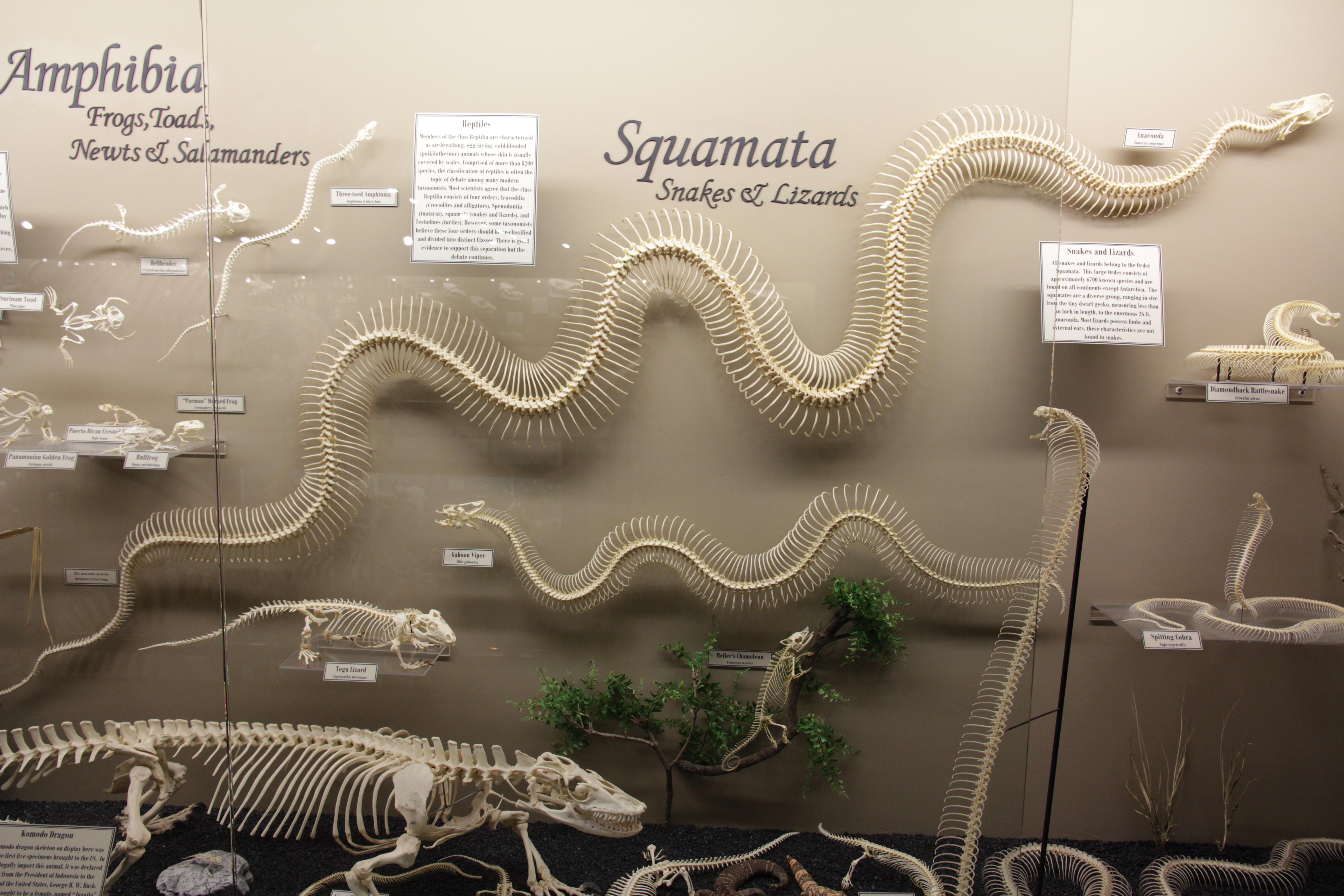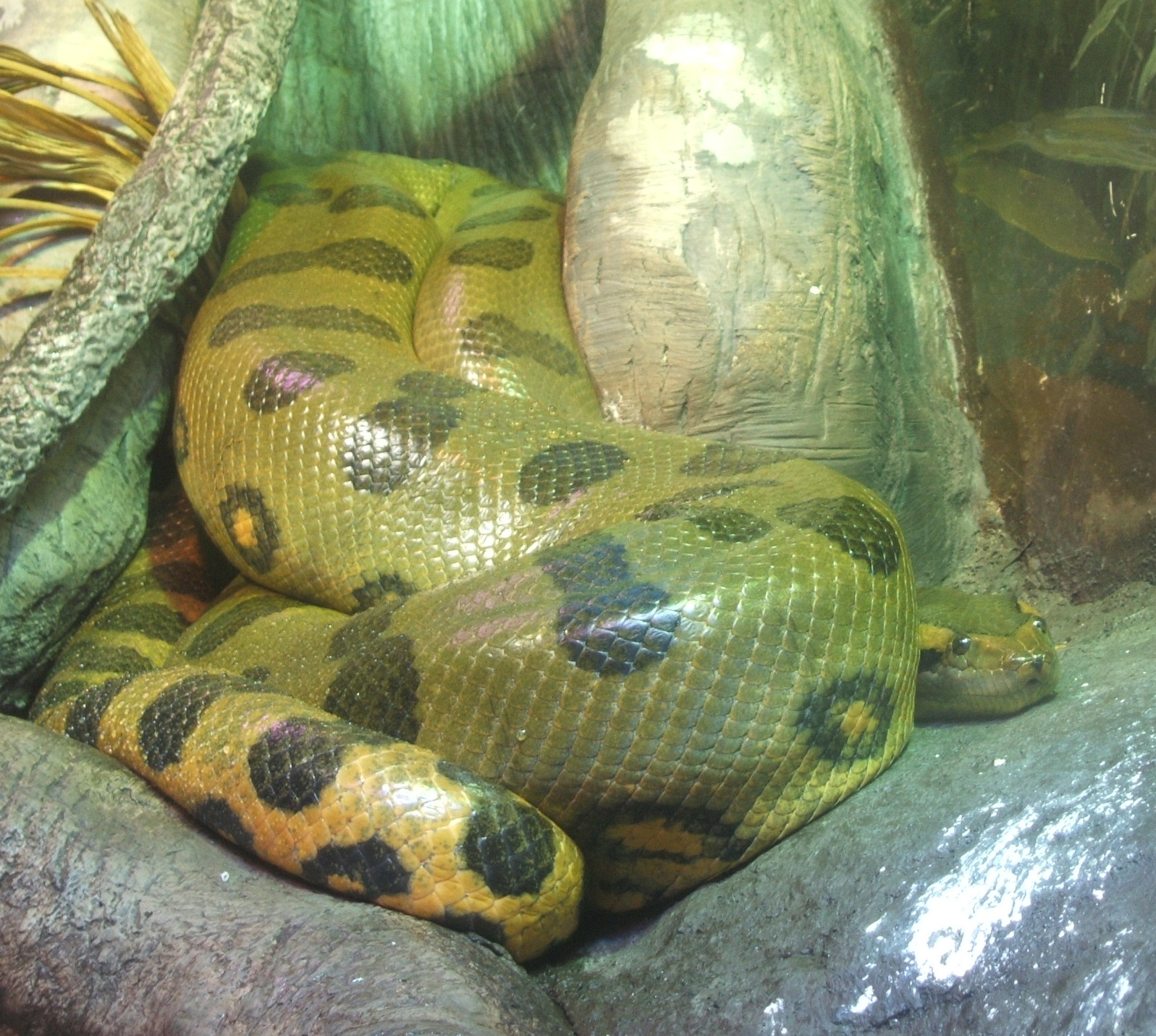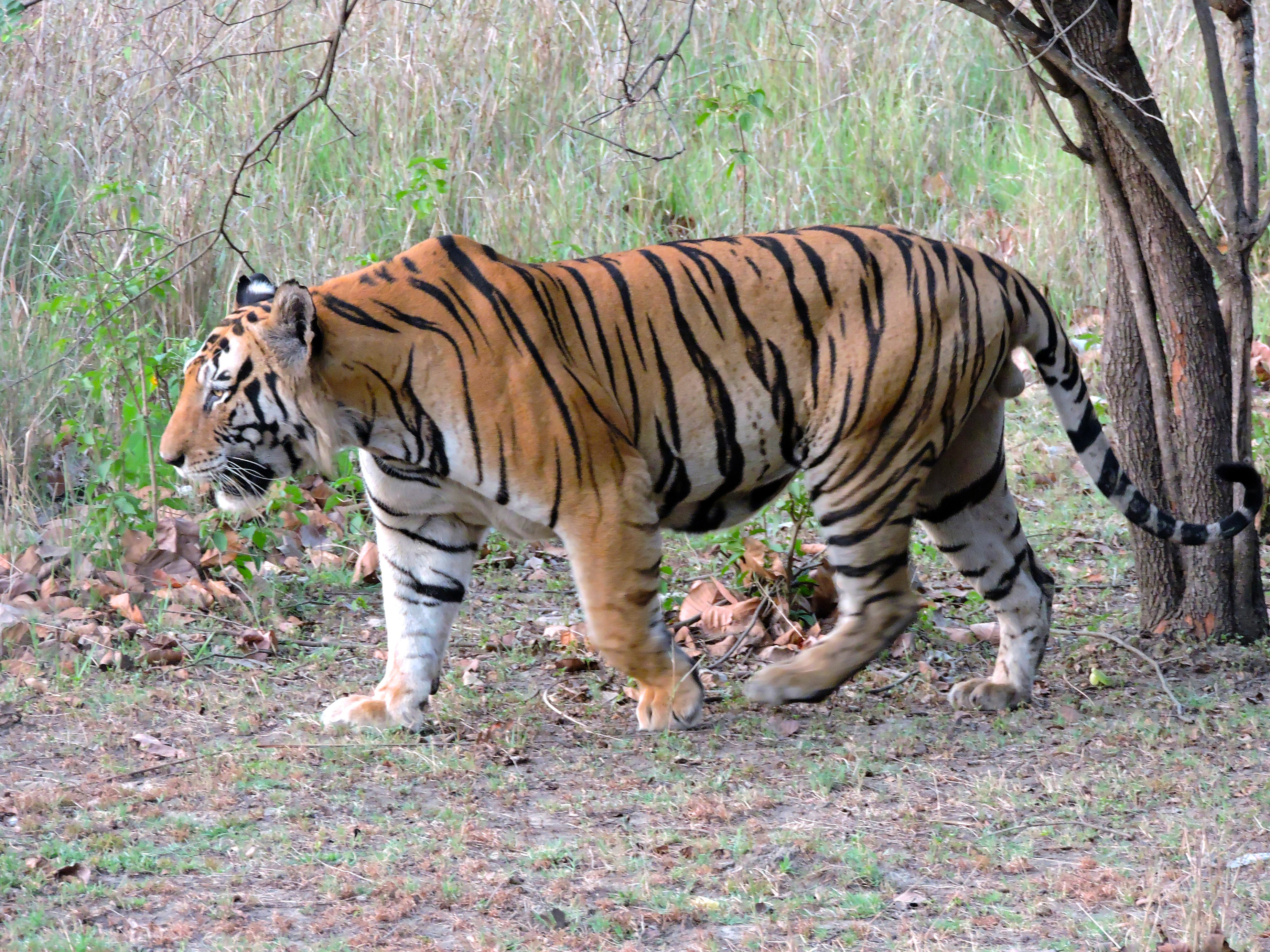|
Eunectes
Anacondas or water boas are a group of large boas of the genus ''Eunectes''. They are a semiaquatic group of snakes found in tropical South America. Three to five extant and one extinct species are currently recognized, including one of the largest snakes in the world, ''E. murinus'', the green anaconda. Description Although the name applies to a group of snakes, it is often used to refer only to one species, in particular, the common or green anaconda (''Eunectes murinus''), which is the largest snake in the world by weight, and the second longest after the reticulated python. Origin The recent fossil record of ''Eunectes'' is relatively sparse compared to other vertebrates and other genera of snakes. The fossil record of this group is effected by an artifact called the Pull of the Recent. Fossils of recent ancestors are not known, so the living species 'pull' the historical range of the genus to the present. Etymology The name ''Eunectes'' is derived from . The Sout ... [...More Info...] [...Related Items...] OR: [Wikipedia] [Google] [Baidu] |
Green Anaconda
The green anaconda (''Eunectes murinus''), also known as the giant anaconda, emerald anaconda, common anaconda, common water boa, or southern green anaconda, is a semi-aquatic boa species found in South America and the Caribbean island of Trinidad. It is the largest, heaviest, and second longest (after the reticulated python) snake in the world. No subspecies are currently recognized, but there are two different species that have the name of the Green Anaconda which are the Northern Green Anaconda and Southern Green Anaconda. Like all boas, it is a non-venomous constrictor. The term "anaconda" often refers to this species, though the term could also apply to other members of the genus '' Eunectes''. Fossils of the snake date back to the Late Pleistocene in the Gruta do Urso locality. Taxonomy In the famous ''10th edition of Systema Naturae'' of 1758, Carl Linnaeus cited descriptions by Albertus Seba and by Laurens Theodorus Gronovius to erect the distinct species ''murina' ... [...More Info...] [...Related Items...] OR: [Wikipedia] [Google] [Baidu] |
Eunectes Murinus
The green anaconda (''Eunectes murinus''), also known as the giant anaconda, emerald anaconda, common anaconda, common water boa, or southern green anaconda, is a semi-aquatic Boinae, boa species found in South America and the Caribbean island of Trinidad. It is the List of largest snakes, largest, heaviest, and second longest (after the reticulated python) snake in the world. No subspecies are currently recognized, but there are two different species that have the name of the Green Anaconda which are the Northern Green Anaconda and Southern Green Anaconda. Like all boas, it is a venom, non-venomous Constriction, constrictor. The term "anaconda" often refers to this species, though the term could also apply to other members of the genus ''Eunectes''. Fossils of the snake date back to the Late Pleistocene in the Gruta do Urso locality. Taxonomy In the famous ''10th edition of Systema Naturae'' of 1758, Carl Linnaeus cited descriptions by Albertus Seba and by Laurens Theodorus Gr ... [...More Info...] [...Related Items...] OR: [Wikipedia] [Google] [Baidu] |
Boinae
The Boinae are a purported subfamily of boas found in Central and South America, as well as the West Indies. In the Integrated Taxonomic Information System (ITIS), ''Boinae'' is considered an invalid synonym of Boidae. Genera *) Not including the nominate subspecies. T) Type genus. Taxonomy The genera '' Acrantophis'' and '' Sanzinia'' were erroneously synonymized with the genus '' Boa'' by Kluge in 1991. These have now been transferred to the resurrected subfamily Sanziniinae. The genus '' Candoia ''has similarly been transferred to its own subfamily, Candoiinae. See also * List of boine species and subspecies References Further reading * Kluge AG. 1991. Boine Snake Phylogeny and Research Cycles. Misc. Pub. Museum of Zoology, Univ. of Michigan No. 178PDFaUniversity of Michigan Library Accessed 8 July 2008. External links BoinaeaZipcodeZoo.com Accessed 14 July 2008. * {{Authority control Extant Paleocene first appearances Snake subfamilies Taxa named by ... [...More Info...] [...Related Items...] OR: [Wikipedia] [Google] [Baidu] |
Snake
Snakes are elongated limbless reptiles of the suborder Serpentes (). Cladistically squamates, snakes are ectothermic, amniote vertebrates covered in overlapping scales much like other members of the group. Many species of snakes have skulls with several more joints than their lizard ancestors and relatives, enabling them to swallow prey much larger than their heads ( cranial kinesis). To accommodate their narrow bodies, snakes' paired organs (such as kidneys) appear one in front of the other instead of side by side, and most only have one functional lung. Some species retain a pelvic girdle with a pair of vestigial claws on either side of the cloaca. Lizards have independently evolved elongate bodies without limbs or with greatly reduced limbs at least twenty-five times via convergent evolution, leading to many lineages of legless lizards. These resemble snakes, but several common groups of legless lizards have eyelids and external ears, which snakes lack, althoug ... [...More Info...] [...Related Items...] OR: [Wikipedia] [Google] [Baidu] |
Henry Yule
Colonel (United Kingdom), Colonel Sir Henry Yule (1 May 1820 – 30 December 1889) was a Scottish Oriental studies, Orientalist and geographer. He published many travel books, including translations of the work of Marco Polo and ''Mirabilia'' by the 14th-century Dominican Order, Dominican Friar Jordan Catala, Jordanus. He was also the compiler of a dictionary of Anglo-Indian terms, the ''Hobson-Jobson'', with Arthur Coke Burnell. Early life Henry Yule was born at Inveresk near Edinburgh in Scotland on 1 May 1820. He was the youngest son of Major William Yule (1764–1839) and his wife Elizabeth Paterson (died circa 1827). William Yule had served as an officer in Bengal Army#Under East India Company, the Bengal army of the East India Company and had retired in 1806. William's uncle was the botanist John Yule (botanist), John Yule FRSE. Elizabeth died before Henry was eight and William moved to Edinburgh with his sons, where Henry attended the Royal High School, Edinburgh, ... [...More Info...] [...Related Items...] OR: [Wikipedia] [Google] [Baidu] |
Hobson-Jobson
''Hobson-Jobson: A Glossary of Colloquial Anglo-Indian Words and Phrases, and of Kindred Terms, Etymological, Historical, Geographical and Discursive'' is a historical dictionary of Anglo-Indian words and terms from Indian languages which came into use during British rule in India. It was written by Sir Henry Yule and Arthur Coke Burnell and first published in 1886. Burnell died before the work was finished, and most of it was completed by Yule, who acknowledged Burnell's detailed contributions. A subsequent edition was edited by William Crooke in 1903, with extra quotations and an index added. The first and second editions are collector's items; the second edition is widely available in facsimile. The dictionary holds over 2,000 entries, generally with citations from literary sources, some of which date to the first European contact with the Indian subcontinent, frequently in other non-English European languages. Most entries also have etymological notes. Background The p ... [...More Info...] [...Related Items...] OR: [Wikipedia] [Google] [Baidu] |
Tiger
The tiger (''Panthera tigris'') is a large Felidae, cat and a member of the genus ''Panthera'' native to Asia. It has a powerful, muscular body with a large head and paws, a long tail and orange fur with black, mostly vertical stripes. It is traditionally classified into nine Holocene, recent subspecies, though some recognise only two subspecies, mainland Asian tigers and the island tigers of the Sunda Islands. Throughout the tiger's range, it inhabits mainly forests, from coniferous and temperate broadleaf and mixed forests in the Russian Far East and Northeast China to tropical and subtropical moist broadleaf forests on the Indian subcontinent and Southeast Asia. The tiger is an apex predator and preys mainly on ungulates, which it takes by ambush. It lives a mostly solitary life and occupies home ranges, defending these from individuals of the same sex. The range of a male tiger overlaps with that of multiple females with whom he mates. Females give birth to usually two or ... [...More Info...] [...Related Items...] OR: [Wikipedia] [Google] [Baidu] |
South Asia
South Asia is the southern Subregion#Asia, subregion of Asia that is defined in both geographical and Ethnicity, ethnic-Culture, cultural terms. South Asia, with a population of 2.04 billion, contains a quarter (25%) of the world's population. As commonly conceptualised, the modern State (polity), states of South Asia include Bangladesh, Bhutan, India, the Maldives, Nepal, Pakistan, and Sri Lanka, with Afghanistan also often included, which may otherwise be classified as part of Central Asia. South Asia borders East Asia to the northeast, Central Asia to the northwest, West Asia to the west and Southeast Asia to the east. Apart from Southeast Asia, Littoral South Asia, Maritime South Asia is the only subregion of Asia that lies partly within the Southern Hemisphere. The British Indian Ocean Territory and two out of Atolls of Maldives, 26 atolls of the Maldives in South Asia lie entirely within the Southern Hemisphere. Topographically, it is dominated by the Indian subcontinent ... [...More Info...] [...Related Items...] OR: [Wikipedia] [Google] [Baidu] |
Frank Wall (herpetologist)
Colonel Frank Wall (21 April 1868 – 19 May 1950) was a physician and herpetologist who lived in Sri Lanka and India. Early life and education Wall was born in Colombo, Ceylon (now Sri Lanka). His father, George Wall, was responsible for initiating the study of natural history on the island. Wall was sent to England to be educated at Harrow School, the same school his father and brothers attended, and studied medicine in London before joining the Indian Medical Service in 1893.Beolens, Bo; Watkins, Michael; Grayson, Michael (2011). ''The Eponym Dictionary of Reptiles''. Baltimore: Johns Hopkins University Press. xiii + 296 pp. . ("Wall", p. 279). Herpetology Sent to India under the British Raj, Wall continued to work there until 1925 and researched many animals, especially snakes. He collected numerous snakes, many of which are now in the collections of the British Museum and the Natural History Museum, London. Wall was a member of the Bombay Natural History Society and pu ... [...More Info...] [...Related Items...] OR: [Wikipedia] [Google] [Baidu] |





